Body language in chickens

2023-08-30 14:38:09
Body language in chickens
Chicken body language
(Source: "poultry" magazine:(Your Chickens - May 2016 )
We can know a lot about the chickens we raise through their body language, and in this article we learn how to read body language in chickens..
* Communication between chickens:
Communication between chickens is complicated.Scientists, those who closely monitor the behavior of their flock of chickens, have learned that this type of bird can be cunning and deceitful.Communication between chickens is not limited to vocal communication; chickens have a stock of visual displays, or body language for communication, and Exchange a wide range of information.Chickens use complex signals to express what they want, when they are going to make certain decisions; taking into account their previous experiences and surrounding knowledge of the situation, scientists understand that communication between chickens is on a par with communication between animals from the division of primates.
The Oxford Dictionary defines body language as "conscious, unconscious movements, postures; through which inclinations, feelings are transmitted".Body language can be expressed by physical behaviors, such as facial expressions, body posture, gestures, eye movements, touch, and the use of space.
* Sovereignty:
As birds that live in flocks, chickens have a complex social hierarchy system; there is an arrangement for both males and females to pick up grain, or peck feed.Each member of the herd has a certain social status, which is known to other members of the herd.This dynamic social arrangement affects several activities of chickens, including: eating, drinking, laying eggs, mating, laying eggs, laying dirt on the body with the dominant individuals of the flock, who have priority access to food, shelter, mating.
The order of the role in the pecking of the feed is often established, leading to the strengthening of leadership in the flock;through a sharp click, the dominant individual in the flock of chickens directs it to the head or neck of the weaker bird.In small, tight-knit herds with plenty of food and space, strong competition between herd members is usually not necessary; rather, the dominant individual often directs a quick click to the individuals under his control from time to time to convey some message that everyone should respect him, give him priority!
Another type of body language is also used among chickens, namely loud wing flapping with the head held high, chest blowing, since such a show of a dominant individual inside the flock expresses dominance, while flapping wings with a lowered head, running in the opposite direction to the opposite chicken is a way to show submission from an individual without any physical contact between chickens.
As for ruffling feathers in the form of a pirate, with the head lowered in the stimulation position, it is used as a technique of intimidation by dominant Roosters, small cocks, both large and small chickens; if none of the chickens backs down, a fight is likely to ensue, the intensity of which depends on how important it is to determine the height of a bird's rank; the two birds about to fight will be watching each other, often casually circling each other, pretending to glance at something on the ground while observing each other.The fight begins when the birds raise their feathers like a pirate, point their wings towards the ground,spread them away from their bodies while standing as high as possible, and try to confront their opponent while he is in If no bird retreats, the clucking will begin between the struggling birds, jumping on each other, beating each other with their wings, while the submissive individuals show their submission by lying in place, or running away.
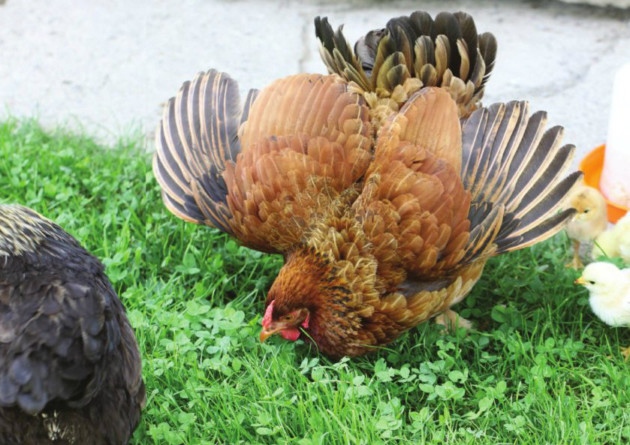

However, leadership can have a price;the male in control of the flock must always be vigilant, not only to protect his beloved chickens, but to ensure that the individuals under his leadership do not think about changing their status, and dispute him for leadership; he remains careful all the time to stand in a position that shows him taller, erect, chest puffed to show his authority and leadership.Birds newly joined to the flock are often prone to aggression during their recognition of their rank among the flock members, and this can be done simply by communicating by looking, in the form of a face-to-face fight, by tapping the head and neck, or chasing the new bird away.
The method of posture and body position acquires importance during a pecking attack; the dominant Bird will raise its head higher than the level of the other bird's head, and then it will peck at its Mane, head, neck and appendage hanging from its neck, while the submissive bird freezes in place immediately with its whole body lowered before retreating.
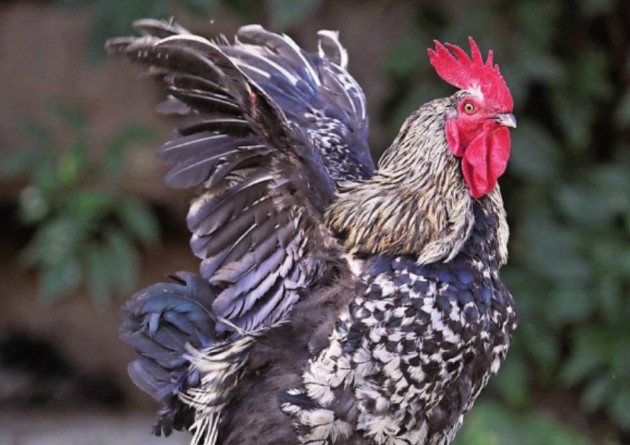
The brooding hen uses body language to defend her young in the face of predators, and other members of the flock who have invaded her personal space, she will portray herself as twice her normal height, fluff her feathers in the form of a pirate, raising her wings outward, and this frightening situation is enough to make the most curious bird to turn away!
* Chickens in cases of illness, reassurance:
Chickens are often adept at hiding the symptoms of their disease.His body language can indicate that something is not quite right.Signs that indicate the presence of a bug may include the hen standing bent, with its neck bent, its feathers are ruffled, and its tail is bent down, however, these signs do not necessarily mean the presence of a pathological condition, as a number of chickens tend to show this body language on bad weather days to express boredom!.With the length of time a breeder has been in contact with his chicken flock, he can distinguish between different expressions of chickens, and he knows when attention is needed.
Chickens also express a state of satisfaction through body language; close friends stand glued to each other, their bodies may relax and fall asleep.As soon as the priority system of clicking arises, there is an acute awareness of the herd members of personal space.One might expect dominant females to remain close to the dominant rooster, while subordinates stay closer from the periphery, well aware of the aggressive responses they are likely to get if they invade the personal space of the dominant.However, the social behaviors of chickens are not so simple!
* Body language during mating:
Males perform complex visual displays related to the discovery of food,most notably a series of actions through which he
The dominant Rooster calls the chicken for food by shouting, repeatedly moving his head and neck rhythmically, and his movements also include picking up and dropping a food item, and then the female will come to take the piece of food, if she squats, this is an invitation to mating, and this exhibitionist method is the Rooster's main way to attract his mate.
And it seems that the subordinate male has no chance of luring a mate, unless, of course, he is evasive and uses subtle methods to attract the hen ! Scientists have noticed that dominant males respond to the calls to eat by submissive males, meet their insidious offer with outright aggression, drive away, and in the meantime the deceitful male singles out the hen!
And the submissive male modifies the female's courtship signals, where he only does the visible part of picking up and dropping food when the dominant male is attentive, thus inventing a new signal that quietly attracts a mate to him while avoiding the anger of the dominant rooster, and when the dominant male is absent-minded, or for example busy beautifying his body; the cunning submissive male performs his display that eavesdrops on the female's response.
* Warning signs:
Body language is often used in conjunction with sounds to convey specific information that other chickens understand.When a warning signal is given alerting the flock to the presence of a terrestrial predator, the language will be understandable without the birds listening to the predator signal seeing.The bird's warning signal will be directed in the direction of danger, as if pointing to it for others to notice, and the flock members respond by standing upright, scanning the horizon, and may flee in search of a cover protecting them, or fly to neighboring trees, as terrestrial predators hunt using ambush techniques, and it is more likely to end the hunting attempt if detected, so it is important for the flock to publicly display their vigilance.
And since predators flying in the air depend on the speed of attack from a distance, a slightly different tactic is adopted by the herd; a rooster who detects an overt threat will bend down and turn his left eye to the sky to watch the threat while his right eye watches his companions and rivals.The female's reaction to aerial predators is to bow and smooth her plumage, as if trying to make herself invisible, and she will run away only as soon as the predator approaches her.
*Other features:
Chicken body language is the product of ongoing evolutionary processes, and it encompasses much more than the range of these traits we mentioned earlier; chickens touch, turn, just like we do.And since chickens are able to remember and recognize more than 100 individuals, including humans, the breeder should keep in mind that they are part of the chicken flock! Through long-term cohabitation between the breeder and the chicken herd, a common language can be established between them, in which the chickens understand the breeder's signals or his methods of feeding or watering and respond to him.
Read more about lameness in poultry and ways to overcome this problem
الموضوعات المشابهه

Manufacturing a domestic product that competes with

The minister of Agriculture announces the release

Your guide to veterinary medicines
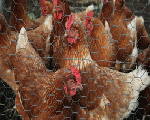
Some common diseases in poultry

Contract agriculture and its relationship to sustainable
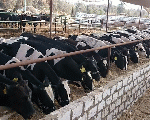
26 cattle and 1400 chickens died in

Inflammation of the navel in chicks

Tips for broiler breeders to deal with

The poultry industry between the challenges of
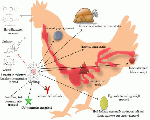
The role of chromium in the health

What's after spawning.?

Agriculture receives an official delegation from the

Comments
Add comment